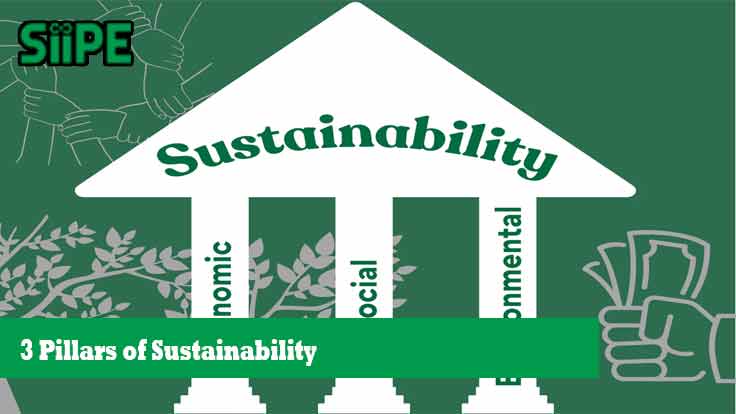Sustainability has become more than just a buzzword. It is now a guiding principle for businesses, governments, and communities worldwide. At the heart of sustainable development lies a framework known as the 3 pillars of sustainability. These three pillars—environmental, social, and economic—work together to ensure that progress today does not compromise the ability of future generations to thrive.
In this article, we will explore what each pillar means, why they matter, and how they connect to real-world practices.
What Are the 3 Pillars of Sustainability?
The 3 pillars of sustainability represent the foundation of long-term development. Each pillar addresses a different but interconnected dimension of sustainability:
-
Environmental Sustainability – Protecting the planet and its natural resources.
-
Social Sustainability – Supporting people, communities, and social well-being.
-
Economic Sustainability – Ensuring financial growth and stability without harming future prospects.
When these three dimensions are balanced, businesses and societies can achieve growth that is responsible, ethical, and future-proof.
Pillar 1: Environmental Sustainability
The environmental pillar focuses on protecting the Earth’s natural resources. This includes reducing waste, conserving energy, and preventing pollution. Without a healthy environment, other pillars of sustainability cannot exist.
Key Practices in Environmental Sustainability
-
Renewable Energy Use: Shifting from fossil fuels to solar, wind, and hydropower.
-
Resource Efficiency: Designing products and buildings with minimal energy and material waste.
-
Biodiversity Protection: Preserving forests, oceans, and wildlife habitats.
-
Sustainable Supply Chains: Encouraging eco-friendly sourcing and reducing carbon footprints.
Companies adopting environmental sustainability not only comply with global regulations but also build stronger brand reputations.
Pillar 2: Social Sustainability
The social pillar emphasizes people and community well-being. It is about fairness, equity, and improving quality of life. Organizations must consider how their operations impact employees, customers, and local communities.
Key Aspects of Social Sustainability
-
Human Rights Protection: Ensuring safe working conditions and fair wages.
-
Diversity and Inclusion: Promoting equal opportunities regardless of gender, race, or background.
-
Community Engagement: Supporting education, health, and social development.
-
Work-Life Balance: Fostering healthy and productive workplaces.
Strong social sustainability leads to trust, loyalty, and long-term stakeholder relationships.
Pillar 3: Economic Sustainability
The economic pillar ensures businesses and societies can grow without draining resources or creating inequality. It focuses on stable, resilient economies that balance profit with responsibility.
Elements of Economic Sustainability
-
Innovation and Efficiency: Developing products and services that are both profitable and sustainable.
-
Responsible Investment: Directing capital towards green and ethical industries.
-
Long-Term Value Creation: Prioritizing resilience over short-term profit.
-
Sustainable Job Creation: Building industries that provide stable employment without harming the planet.
A strong economic foundation ensures that environmental and social initiatives can continue for generations.
Why the 3 Pillars Must Work Together
The 3 pillars of sustainability are interdependent. For example:
-
A company can achieve economic success, but if it harms the environment, it risks long-term survival.
-
A project may protect the environment, but if it ignores communities, it creates social imbalance.
-
A socially beneficial program must also be financially sustainable to endure.
This interconnectedness is often represented by the Triple Bottom Line (TBL) approach: People, Planet, Profit.
Real-World Applications of the 3 Pillars
-
Green Industrial Estates: Combining renewable energy, community engagement, and long-term profitability.
-
Corporate ESG Policies: Businesses reporting on Environmental, Social, and Governance performance.
-
Sustainable Cities: Governments integrating clean transport, social housing, and resilient economies.
-
Circular Economy Models: Companies reusing resources while creating jobs and reducing costs.
These applications show that sustainability is not just theory—it is practical and achievable.
Challenges in Balancing the Pillars
Even though the framework is clear, implementing it is not always easy. Some common challenges include:
-
High Costs: Initial investment in renewable technologies can be expensive.
-
Policy Gaps: Weak regulations slow down progress in sustainability.
-
Conflicting Interests: Short-term profits often compete with long-term sustainability goals.
-
Cultural Barriers: Different regions may prioritize one pillar over others.
Overcoming these challenges requires strong leadership, innovation, and collaboration across sectors.
The Future of the 3 Pillars of Sustainability
As global challenges such as climate change, inequality, and economic instability continue to grow, the 3 pillars of sustainability will play an even greater role. Businesses and governments are expected to adopt stronger ESG strategies, embrace green technologies, and invest in socially responsible projects.
The future lies in aligning all three pillars to create a resilient, inclusive, and eco-friendly world.
The 3 pillars of sustainability—environmental, social, and economic—are essential for building a balanced and thriving future. Each pillar is powerful on its own, but only when they are integrated can true sustainability be achieved.
Whether you are a policymaker, a business leader, or an individual, embracing these three dimensions will help ensure that growth today does not compromise the well-being of tomorrow.











